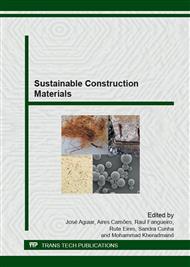[1]
K.S. Kumar, C. Natraja, R. Raman, Sustainable use of waste materials in concrete structures, India Conference (INDICON), Annual IEE (2011), pp.1-7.
Google Scholar
[2]
J.J. Kim, B. Rigdon, Qualities, Use, and Examples of Sustainable Building Materials, Sust. Build. Mater. (1998) 1-44.
Google Scholar
[3]
R.V. Alunno, F. Medici, Inertization of toxic metals in cement matrices: Effects on hydration, setting and hardening, Cem. Concr. Res. 25 (1995) 1147–52.
DOI: 10.1016/0008-8846(95)00106-m
Google Scholar
[4]
J.R. Conner, S.L. Hoeffner, A critical review of stabilization/solidification technology – Critical reviews, Environ. Sci. Technol. 28 (1998) 325–96.
Google Scholar
[5]
R.B. Kogbara, A review of the mechanical and leaching performance of stabilised/solidified contaminated soils, Environ. Rev. 22 (1) (2014) 66-86.
DOI: 10.1139/er-2013-0004
Google Scholar
[6]
M.R. Vespa, R. Dahn, D. Grolimund, M. Harfouche, E. Wieland, A.M. Scheidegger, Speciation of heavy metals in cement-stabilized waste forms: A micro-spectroscopic study, J. Geochem. Explor. 88 (2006) 77-80.
DOI: 10.1016/j.gexplo.2005.08.093
Google Scholar
[7]
Q.Y. Chen, M. Tyrer, C.D. Hills, X.M. Yang, P. Carey, Immobilization of heavy metal in cement-based solidification/stabilization – a review, Waste Manag. 29 (2009) 390-403.
DOI: 10.1016/j.wasman.2008.01.019
Google Scholar
[8]
C. Jantzen, A. Johnson, D. Read, J. A. Stegemann, Cements in waste management, Adv. Cem. Res. 22 (4) (2010) 225-31.
Google Scholar
[9]
A.K. Minocha, N. Jain, C.L. Verma, Effect inorganic materials on solidification of heavy metal sludge, Cem. Concr. Res. 33 (2003) 1695-701.
DOI: 10.1016/s0008-8846(03)00146-7
Google Scholar
[10]
E. Gruyaert, N. Robeyst, N. Belie, J. Therm. Anal. Calorim. 102 (3) (2010) 941-51.
Google Scholar
[11]
J. Dweck, C.A. Pinto, P.M. Büchler, Study of a Brazilian spent catalyst as cement aggregate by thermal and mechanical analysis, J. Therm. Anal. Calorim. 92 (2008) 121-7.
DOI: 10.1007/s10973-007-8750-z
Google Scholar
[12]
A. Chaipanich and T. Nochaiya, Thermal analysis and microstructure of Portland cement -fly ash-silica fume pastes, J. Therm. Anal. Calorim. 99 (2) (2010) 487-93.
DOI: 10.1007/s10973-009-0403-y
Google Scholar
[13]
A.L.C. Cunha, M.S. Lemos, S. Meth, J.P. Gonçalves, J. Dweck, A study of the particle size effect on the pozzolanic activity of an equilibrium catalyst, J. Therm. Anal. Calorim. 106(3) (2011) 805-9.
DOI: 10.1007/s10973-011-1399-7
Google Scholar
[14]
Brazilian Association of Technical Standards (ABNT), NBR10. 004. Solid waste – classification. (2004) (in Portuguese).
Google Scholar
[15]
M.B.M. Melchert, M.M. Viana, J. Dweck, P.M. Büchler, The study of solidification of two catalyst wastes in mortar, In: VIII Brazilian Congress and III Pan American Congress on Thermal Analysis and Calorimetry (CBRATEC), Anais (2012) 1-4.
Google Scholar
[16]
E. Hekal, E. Kishar, W. Hegazi, M. Mohamed, Immobilization of Co(II) ions in cement pastes and their effects on the hydration characteristics, J. Mater. Sci. Technol. Vol. 27(1) (2011) 74-80.
DOI: 10.1016/s1005-0302(11)60029-7
Google Scholar
[17]
J. Dweck, P.M. Büchler, A.C.V. Coelho, F.K. Cartledge, Hydration of a Portland cement blended with calcium carbonate, Thermochim. Acta. Vol. 346(1) (2000) 105-13.
DOI: 10.1016/s0040-6031(99)00369-x
Google Scholar
[18]
Brazilian Association of Technical Standards (ABNT), NBR 7215. Portland Cement - Determination of compressional strength. (1996) (in Portuguese).
Google Scholar
[19]
Brazilian Association of Technical Standards (ABNT), NBR 10. 005. Leaching of solid residues – procedure. (2004) (in Portuguese).
Google Scholar
[20]
J. Dweck, M.B.M. Melchert, M.M. Viana, F.K. Cartledge, P.M. Büchler, Importance of quantitative thermogravimetry on initial cement mass basis to evaluate the hydration of cement pastes and mortars,J. Therm. Anal. Calorim. 113 (2013) 1481-90.
DOI: 10.1007/s10973-013-3112-5
Google Scholar
[21]
M.B.M. Melchert, M.M. Viana, M.S. Lemos, J. Dweck, P.M. Büchler, Simultaneous solidification of two catalyst wastes and their effect on the early stages of cement hydration, J. Therm. Anal. Calorim. 105(2) (2011) 625-33.
DOI: 10.1007/s10973-011-1330-2
Google Scholar
[22]
E. F. Barth, P. Percin, Stabilization and solidification of hazardous wastes, Pollution technology, review ed., Noyes Data, V. Park Ridge, (1990).
Google Scholar
[23]
A. L. F. Brito, Protocol for the evaluation of materials resulting from the stabilization of waste by solidification process. (2007). 179 f. Thesis, Santa Catarina, Brazil (in Portuguese).
Google Scholar
[24]
J. A. Stegeman, N.R. Buenfeld, Prediction of unconfined compressive strength of cement paste containing industrial wastes, Waste Mang. 23 (2003) 321-32.
DOI: 10.1016/s0956-053x(02)00062-4
Google Scholar
[25]
New South Wales. Environmental Protection Authority (NSW EPA), EPA99/21. Environmental Guidelines: Assessment, Classification & Management of Liquid and Non-Liquid Wastes, (1999).
Google Scholar


